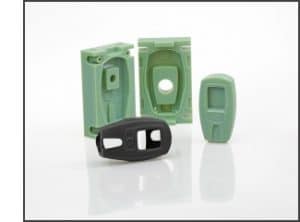Reducing the Cost and Lead Time of Form Tooling with Additive Manufacturing
 Hydroforming is primarily used for low volume forming of sheet metal parts while thermoforming is mainly used for high volume forming of plastic sheets. The tooling used in these processes is typically produced by CNC machining of materials such as aluminum or wood which typically involves high costs and long lead times.
Hydroforming is primarily used for low volume forming of sheet metal parts while thermoforming is mainly used for high volume forming of plastic sheets. The tooling used in these processes is typically produced by CNC machining of materials such as aluminum or wood which typically involves high costs and long lead times.
Advances in additive manufacturing processes and materials now make it possible to create tooling for hydroforming and thermoforming in a fraction of the time and cost of traditional subtractive manufacturing methods. This blog will look at how several companies are using additive manufacturing to more efficiently make hydroforming and thermoforming tooling.
Piper Aircraft uses hydroforming to produce hundreds of different aluminum aircraft structural components such as inner frames, gussets, brackets, skins, etc. CNC machining of hydroforming tools was expensive in the past due to the cost of CNC programming, machine time, skilled labor and material waste involved in subtractive manufacturing.
Many Xerox packages are made with the thermoforming process. Xerox previously machined wooden molds for thermoforming at a cost of $1200 each with a lead time of about a week. Pryer Technology Group (PTG) is a hydroforming press supplier that uses hydroforming to replace damaged or corroded sections of aircraft frames. PTG previously outsourced hydroforming tools from a CNC machining shop that cost $1,500 and took a week to deliver.
 Stratasys Fused Deposition Modeling (FDM) additive manufacturing systems can build hydroforming and thermoforming tooling at a fraction of the cost and in much less time than traditional subtractive machining. Additive manufacturing eliminates the need for CNC programming and skilled labor by producing whatever geometry is required one layer at a time without requiring supervision by a human operator. Additive manufacturing reduces raw material consumption because it consumes only the material needed for the finished part, except for supports which constitute a small fraction of the total material.
Stratasys Fused Deposition Modeling (FDM) additive manufacturing systems can build hydroforming and thermoforming tooling at a fraction of the cost and in much less time than traditional subtractive machining. Additive manufacturing eliminates the need for CNC programming and skilled labor by producing whatever geometry is required one layer at a time without requiring supervision by a human operator. Additive manufacturing reduces raw material consumption because it consumes only the material needed for the finished part, except for supports which constitute a small fraction of the total material.
How thermoforming and hydroforming work
Thermoforming involves shaping thermoplastic sheets or films over a mold with the application of a vacuum or air pressure. A vacuum is most often used which means that many holes must be drilled through the tool to pull the vacuum which drives up manufacturing cost and lead time. The inherent porosity of FDM can be harnessed to draw a vacuum without need for a secondary process. FDM also makes it possible to increase the geometrical complexity of the tooling without increasing its cost, so features such as variable wall thicknesses can be used to control thermal gradients.
Hydroforming uses pressure to form sheet metal to the shape of a mold or die, often with complex curves and small undercuts. Stratasys offers several FDM materials for its line of 3D production systems that withstand the pressures required for hydroforming including acrylonitrile butadiene styrene (ABS) M30, polycarbonate (PC) and Ultem 9085. Tooling made of ABS-M30 can withstand up to 3,000 pounds per square inch (psi), PC tooling handles up to 8,000 psi and Ultem 9085 tools can take 10,000 psi. FDM forming tools are lighter than traditional tooling which makes them easier for operators to handle.
Additive Manufacturing vs. CNC Machining
As a case in point, Piper has achieved substantial lead time savings by switching to FDM PC and Ultem 9085 hydroforming tools. While a typical CNC program takes about four hours to write, the company can program an FDM part in only 10 minutes. Total time to produce the tool has been reduced by 68% to only four and a half days.
FDM also offers the potential for building more complex and organically-shaped parts that will increase the performance and reduce the fuel consumption of future aircraft. Xerox has reduced the cost of making thermoforming molds by 91% to only $103 and reduced lead time by 93% to 4 hours. FDM eliminates the need for costly machining of the mold contour and drilling the holes required to draw the vacuum.
Additive manufacturing also eliminates the geometric restrictions of CNC machining, often making it possible to improve the performance and reduce the cost of the thermoformed part. Producing hydroforming tools with additive manufacturing provides PTG with up to a 70% cost savings and as much as an 80% lead time savings compared to outsourced metal CNC tool fabrication.
Take advantage of additive manufacturing
Additive manufacturing makes it possible to substantially reduce the cost and lead time involved in making thermoforming and hydroforming tools while offering additional design freedom and reducing tooling weight.
This is the fourth and last in a series of blog posts that discuss how additive manufacturing can be used to produce manufacturing aids. In previous posts we have covered jigs and fixtures, molds and composite tooling. In future blogs, we will look at other applications where additive manufacturing can make a positive impact on your bottom line.

 Blog
Blog